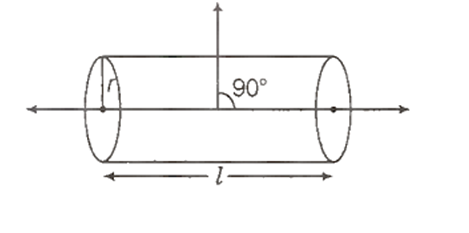 Multiple Choice Questions
Multiple Choice QuestionsTwo infinitely long parallel plates of equal areas 6 cm2 are separated by a distance of 1 cm. While one of the plates has a charge of + 10 nC and the other has − 10 nC. The magnitude of the electric field between the plates, if F/m is
0.6 π kV/m
6 π kV/m
600 π kV/m
60 π V/m
The electric field strength in NC-1 that is required to just prevent a water drop carrying a charge 1.6 x10-19 C from falling under gravity is (g = 9.8 ms-2, mass of water drop = 0.0016 g)
9.8 × 10-16
9.8 × 1016
9.8 × 10-13
9.8 × 1013
A cylinder of radius r and length l is placed in a uniform electric field of intensity E acting parallel to the axis of the cylinder. The total flux over curved surface area is
Zero
C.
Zero

Total flux emerging from the curved surface of the cylinder,
Electric lines of force about a positive point charge are
radially outwards
circular clockwise
radially inwards
parallel straight lines
An electric dipole of moment µ of 400 µC m is placed in a transverse electric field (E) of 50 Vm-1 at an angle of 30° to E. Then, a torque of
10-2 Nm acts along the direction E
10-3 Nm acts along the direction µ
10-2 Nm acts normal to both E and µ
10-3 Nm acts along the direction E
The velocity acquired by a charged particle of mass m and charge Q accelerated from rest by a potential of V is
mQV
An electron moving with a constant velocity v along X-axis enters a uniform electric field applied along Y-axis. Then, the electron moves
with uniform acceleration along Y-axis
without any acceleration along Y-axis
in a trajectory represented as y = ax2
in a trajectory represented as y = ax
A plane square sheet of charge of side 0.5 m has uniform surface charge density. An electron at 1 cm from the centre of the sheet experiences a force of 1.6 x 10-12 N directed away from the sheet. The total charge on the plane square sheet is (ε0 = 8.854 × 10-12 C2 m-2 N-1)
16.25 µC
− 22.15 µC
− 44.27 µC
144.27 µC
The time period of revolution of a charge q1 and of mass m moving in a circular path of radius r due to Coulomb force of attraction with another charge q2 at its centre is
When a comb rubbed with dry hair attracts pieces of paper. This is because the
comb polarizes the piece of paper
comb induces a net dipole moment opposite to the direction of field
electric field due to the comb is uniform
comb induces a net dipole moment perpendicular to the direction of field
